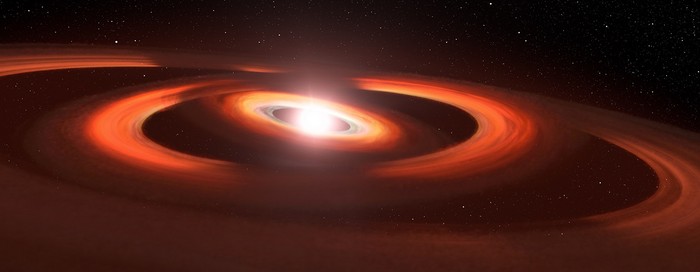Key Points:
- Astronomers have discovered a second shadow between observations stored in the Hubble’s MAST archive.
- The shadow could be from another disk nestled inside the system, and there are likely a pair of planets under construction.
- The disks may be proxies for planets that are lapping each other as they whirl around the star.
Have you ever looked up at the sky and wondered what’s happening up there? A group of astronomers is working hard to find answers. In 2017, they found a shadow sweeping across a gas-and-dust disk around a red dwarf star in the TW Hydrae system. Recently, they discovered a second shadow peeking out from the system. The shadows are evidence of two disks, likely formed by a pair of planets under construction.
The TW Hydrae system is less than 10 million years old and is about 200 light-years away. The system is tilted nearly face-on to our view from Earth, which makes it a great target for studying planetary formation. The second shadow was discovered in June 2021 by comparing the TW Hydrae disk to Hubble observations made several years ago.
The astronomers haven’t found direct evidence of a planet yet, but they can rule out planets more massive than Jupiter. The best solution identified is that two misaligned disks are casting shadows. The simplest explanation is that the misaligned disks are likely caused by the gravitational pull of two planets in slightly different orbital planes.
The suspected planets are located roughly the distance of Jupiter from our Sun. The shadows complete one rotation around the star about every 15 years. These two inner disks are inclined about five to seven degrees relative to the plane of the outer disk, comparable to the range of orbital inclinations inside our solar system.
The outer disk that the shadows are falling on may extend as far as several times the radius of our solar system’s Kuiper belt. This larger disk has a curious gap at twice Pluto’s average distance from the Sun, which may be evidence for a third planet in the system. Inner planets would be difficult to detect because their light would be lost in the glare of the star, and dust in the system would dim their reflected light.
While the astronomers continue to study the TW Hydrae system, we can enjoy the mystery of what’s happening in the skies above. The Hubble Space Telescope and the upcoming James Webb Space Telescope’s infrared vision may help show us even more details in the future!
If our reporting has informed or inspired you, please consider making a donation. Every contribution, no matter the size, empowers us to continue delivering accurate, engaging, and trustworthy science and medical news. Independent journalism requires time, effort, and resources—your support ensures we can keep uncovering the stories that matter most to you.
Join us in making knowledge accessible and impactful. Thank you for standing with us!

